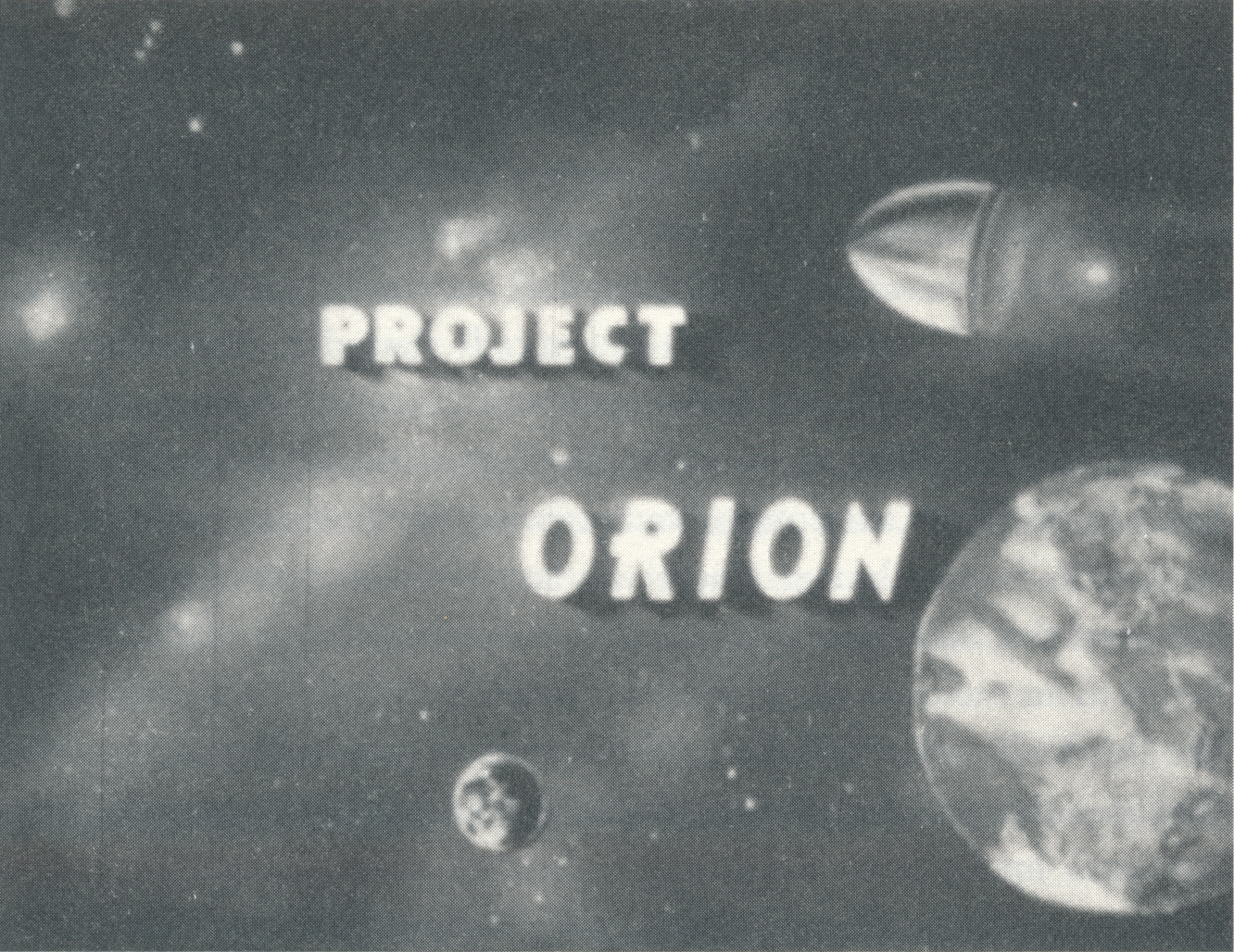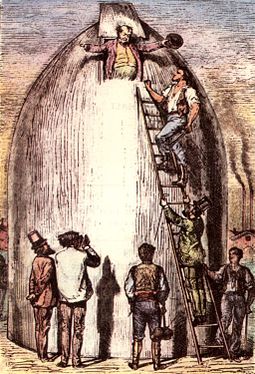


1958
Project Orion
Donald McRae Mixson
and the
Atomic Spaceship

Photo above and story based on the book Project Orion, The true story of the Atomic Spaceship, by George Dyson.

Jules Vern Capsule pictured in the 1872 edition
With World War II ending after the explosion of two atomic bombs over Japan, scientists looked for new non-military uses of atomic bomb. In 1957 a group of scientists led by Freeman Dyson launched a serious attempt to build a four-thousand-ton spaceship propelled by 2,600 atomic bombs and able to put 1600 tons into a 300 mile high orbit. Putting that into perspective, that is ten times more powerful than the Saturn V which put men on the moon, the largest rocket ever built by the U.S. could only put 155 tons into low orbit. The team was inspired by the 1865 Jules Verne science fiction novel From the Earth to the Moon and a Trip Around It, in which a giant gun was built to shoot a capsule to the moon using the then powerful guncotton, imagine using atomic bombs. The team had great visions of missions to Mars by 1965 and to Saturn by 1970.
At first no one in the government took them seriously, come on, using atomic bombs that can wipe out whole cities to blast a rocket into space, that’s just crazy. But the scientists did their research, did their calculations, used their technology to prove, at least on paper, it was feasible and would work. Imagine a huge twenty story high bullet shaped capsule sitting on top of giant shock absorbers with a pusher plate strong enough to withstand an atomic blast at the bottom. Then atomic bombs dropped under the pusher plate every two seconds basting the capsule into space. Like simple right, what could go wrong? In 1959 the Atomic Energy Commission considered the concept viable enough that they filed a patent for a bomb-propelled space vehicle.

Design with bombs being dropped
though hole
in center of pusher plate
Photo from Project Orion, by George Dyson
But the scientist persisted, and the project became a real with funding in 1958 by the Advanced Research Projects Agency (then ARPA now DARPA) took it on and assigned it the project code name Project Orion. The U.S. Air Force soon learned of Project Orion and was brought in with the Air Force Special Weapons Center assigning Captain Donald M. Mixson#927 as their Project Officer overseeing the project. Caption Mixson was well qualified having obtained a Masters in Nuclear Engineering at the Air Force Institute of Technology in 1957. His master’s thesis was most interesting, titled “The Feasibility of the Nuclear Power ION Propelled Space Vessel”. Captain Mixson after reviewing the project, became an enthusiastic supporter. It was said that Capt. Mixon liked the suggestion of putting a hundred tons of tranquilizer powder aboard Orion and spreading it all over Russia.
Of course, there were design problems and issues that needed to be overcome but sometimes the solution had been suggested before. Even with the giant shock absorbers the acceleration could be tolerated using Jules Verne-style couches for the crew. Even so, some of the design was a bit on the wild side when in July Capt. Mixson reported on the atomic bomb delivery system for the spacecraft:
“For the delivery system the hope to avoid the hole in the pusher by using a gun or bazooka, a gun a meter in diameter, walls about 1.5 centimeters, 10 meters long, weighing 2.5 tons to project a 1.5 ton projectile (the atomic bomb) at 200 g’s. Obviously this can’t be reloaded every quarter of a second or so (the rate the bombs would go off) so you need maybe 10 of them. Can be a bazooka but the gun is easier, you need about a hundred kilograms of propellant per shot. This will probably wind up as a battery of Gatling gun-type gadgets.”
Ok, 25 tons of Gatling guns shooting 2,600 three foot diameter atomic bombs at the rate of 4 per second. That sounds like a good idea. But who would fly on such a thing, they all knew that Capt. Donald Mixson would first in line. In August of ’58, Capt. Mixson reported , “Excellent progress has been made in the formulation of a bomb delivery system.”
Capt. Mixson played an important role in the project being the liaison between the Orion scientists and the generals in Washington and the Strategic Air Command writing information bulletins like “Military Implications of the Orion Vehicle” and provide briefings on the military applications of Orion. Capt. Mixson even wrote a proposal for an Orion Deep Space Force in which large maned platforms would lifted into orbit by Orion, seemly crossing the line into science fiction. But it wasn’t all about work for Capt. Mixson, in his spare time he was devoted to weaving and painting. He once said that weaving helped him relax after coming home from a difficult day at work.
With President Kennedy’s “We choose to go to the Moon” speech in 1962 the project Orion team proposed using Orion to get men to the moon, but the technology was untested and a nuclear test ban talks were underway, so it was decided to go with Dr. Wernher von Braun’s conventional chemical rockets to go to the moon. Capt. Mixson later said that Dr. von Braun was welcome to come visit the Orion project anytime.
The nuclear test ban treaty of 1963 was the beginning of the end of Project Orion whose future depended on nuclear tests. The plan limped on, but unable to do any tests, until finally shut down in 1965. The closest they got was in 1959 when they tested a three foot diameter capsule powered by conventional explosives.
In 1964 some of the Project Orion documents were declassified which were read by the science fiction writer Arthur C. Clark who wrote in his diary in 1965 that he had considered making the spaceship Discovery in his classic 2001: A Space Odyssey nuclear powered. In an early edition of the screenplay for the movie, he wrote:
Discovery, 1,000,000 miles from earth. See earth and moon small. We see a blinding flash every 5 seconds from its nuclear pulse propulsion. It strikes against the ship’s thick ablative tail plate.
Donald M. Mixson retired from the Air Force to Northern California, where he pursued his weaving and painting until his death in 1997. In 1979 Freeman Dyson book Disturbing the Universe mentioned Mixson’s 1959 study of a possible military application of Orion, which Mixson responded: “It was written not to make Orion a military machine, but to con a military machine into yet another installment of funds to keep your dream alive. You see, I shared that same dream and it was the only reason I was in the Air Force, NASA did not exist.”
See also Project Orion on Wikipedia
Updated: 12-22-2023
1959..